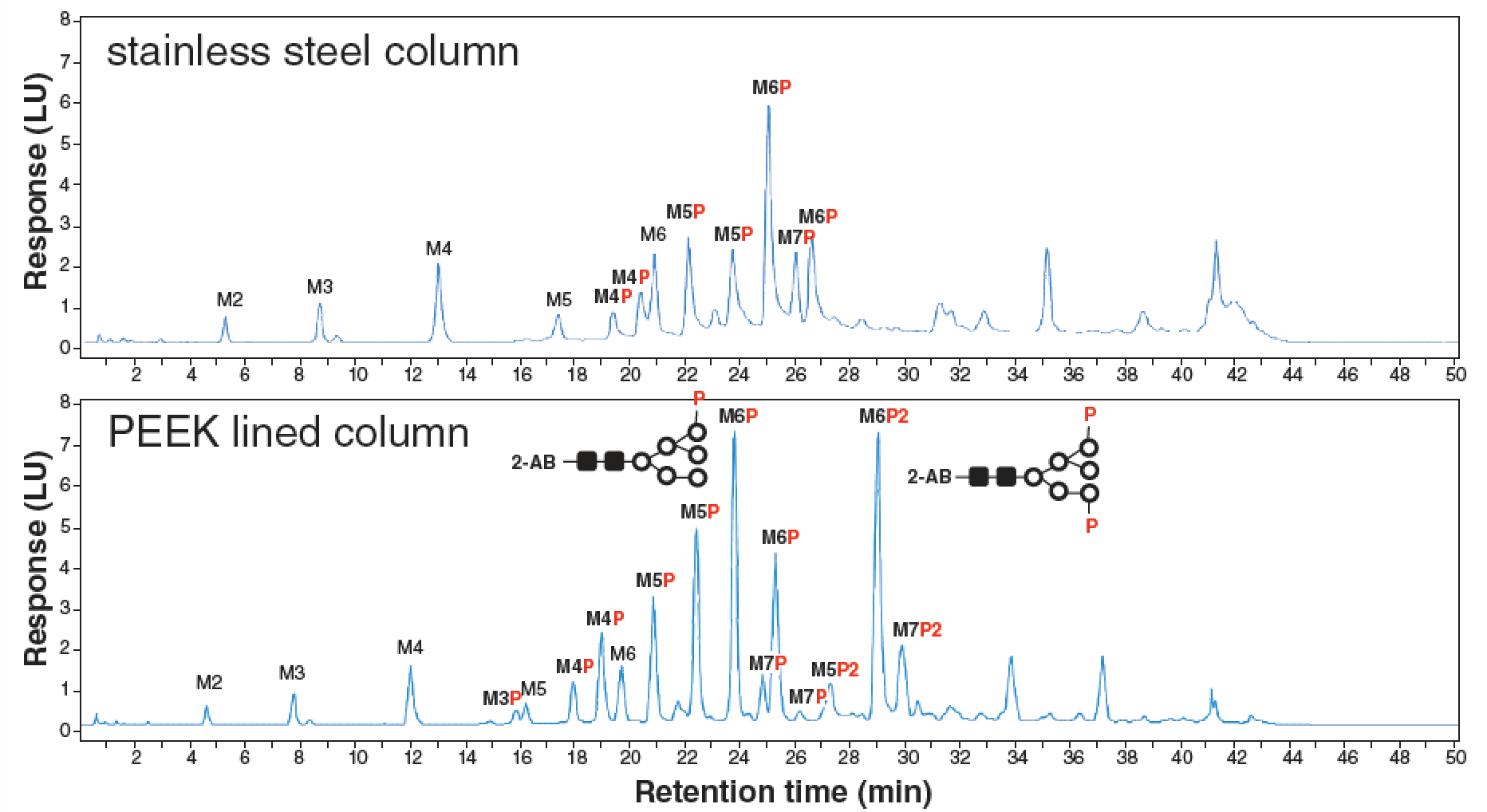Bioanalysis of Small-Molecule Drugs and Metabolites in Physiological Samples by LC–MS, Part 1: Overview
This article is the first of four on the bioanalysis of small-molecule drugs and metabolites by liquid chromatography–mass spectrometry (LC–MS). In this article, we provide an overview of the fundamentals, workflow, regulations, and modern trends on these quantitative assays.
Bioanalysis is the term used to describe the quantitative assessment of drugs and their metabolites in biological fluids (such as blood, plasma, and urine) and tissue homogenates. Bioanalysis plays a pivotal role in the research, discovery, development, and commercialization of new drug therapeutics, and also offers many career opportunities for analytical chemists. Initially, bioanalysis was first used to detect illicit drugs in biological fluids to investigate overdosing in forensic cases. The field then grew from there with the development of pharmacokinetic science (1).
The four white papers for this planned series are:
Part 1: An overview of the fundamentals and regulations.
Part 2: Sample preparation for different sample types.
Part 3: Method development—optimization and best practices.
Part 4: Method validation for regulated bioanalysis.
Part 1 focuses on the bioanalysis of new chemical entities (NCE) in physiological fluids by liquid chromatography–mass spectrometry (LC–MS) in nonclinical and clinical samples. It strives to be a primer for the novice and a guide to the fundamentals of methodologies and regulations for the laboratory scientist. Bioanalysis of large-molecule biotherapeutics is not covered in this part. LC–MS applications and methodologies in biochemical research, drug metabolism, biomarker analysis, and clinical diagnostics are briefly mentioned.
Table 1 lists the common acronyms and brief definitions. Some terms are further described in the text or cited in references. For comprehensive explanations, the reader is referred to books and articles on drug development, pharmacology, pharmacokinetics (PK), drug metabolism (DM), bioanalysis (BA), LC, and MS (2–11).
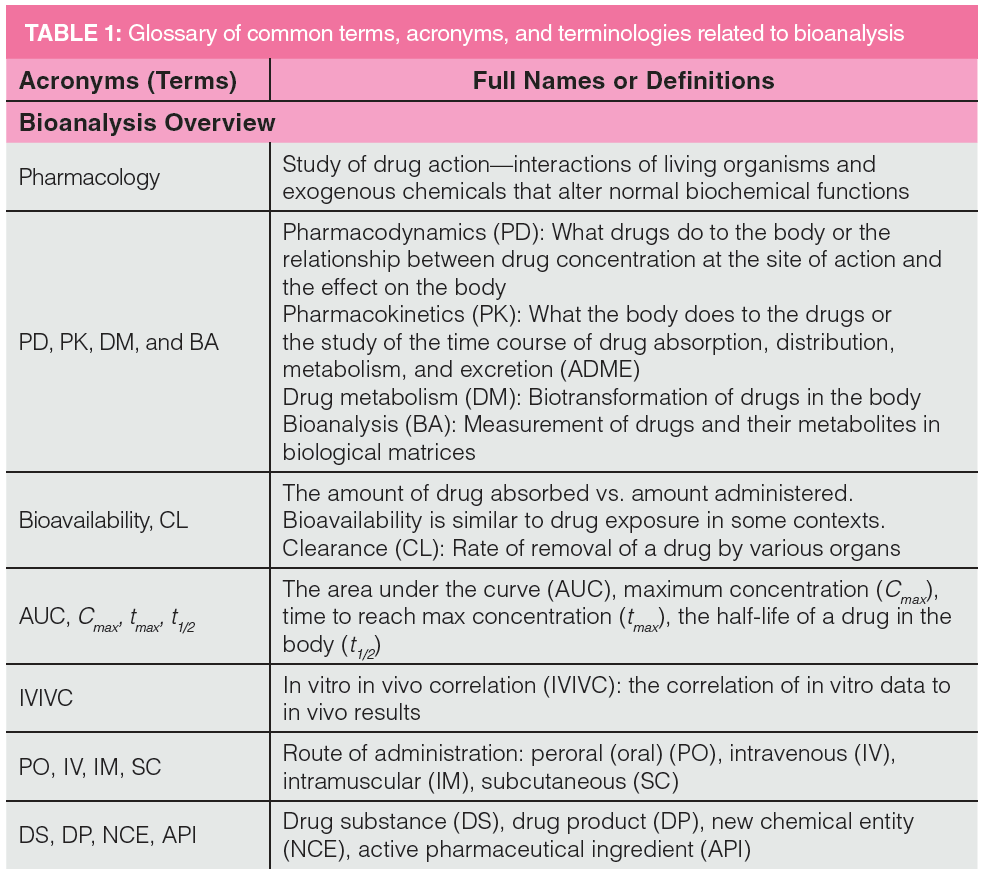
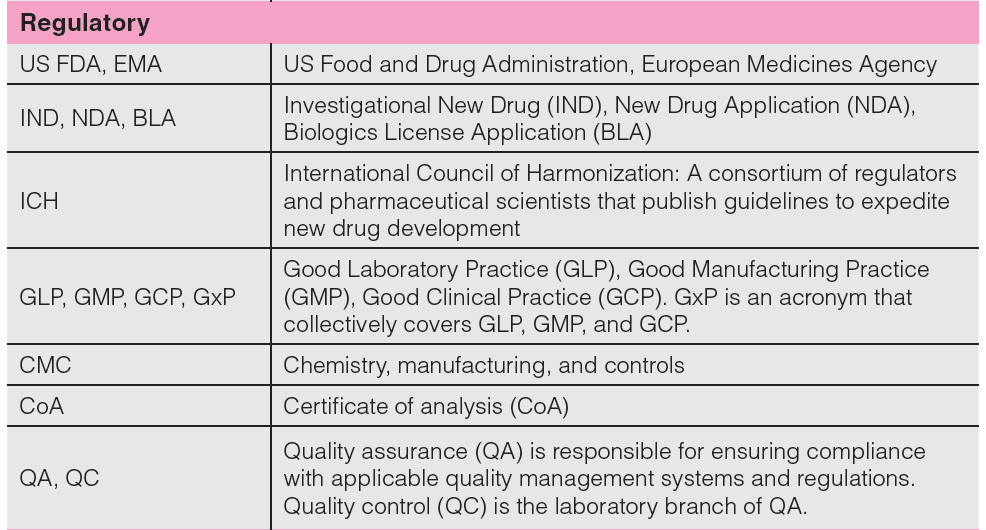

The Role of Bioanalysis in Drug Discovery and Development
The development of new drugs is a complex, expensive, and multidisciplinary process. The modern drug development process often uses a molecular approach, which starts with an understanding of the biology and pathophysiology of the disease, the identification of the molecular target (a receptor or enzyme) responsible for the specific body malfunction, and the synthesis or discovery of a molecule (a small organic molecule or antibody) that binds to a physiological target, thereby mitigating a particular disease state (2). Because the drug must first be bound to the target to be effective, its distribution to the patient’s systemic circulatory system is mandatory unless the drug can be delivered directly to the affected organ or target (3–6). Therefore, it is paramount to have accurate assessments of the drug concentrations in the patient’s physiological fluids after administering the drug to the patient. For small‑molecule drug products, oral dosage forms such as tablets or capsules are generally preferred because of the ease in administering them: The patient ingests oral drug products to release the active pharmaceutical ingredient (API), which is then absorbed from the digestive system into the bloodstream to reach the intended target.
Bioanalysis is conducted during all new drug development phases—including initial research, drug discovery, preclinical, nonclinical, clinical development, and post‑approval studies. Data from bioanalytical studies are collected to support various investigations, as can be seen in Table 2. Readers seeking an in-depth understanding of these topics are encouraged to peruse the relevant references (4–6).
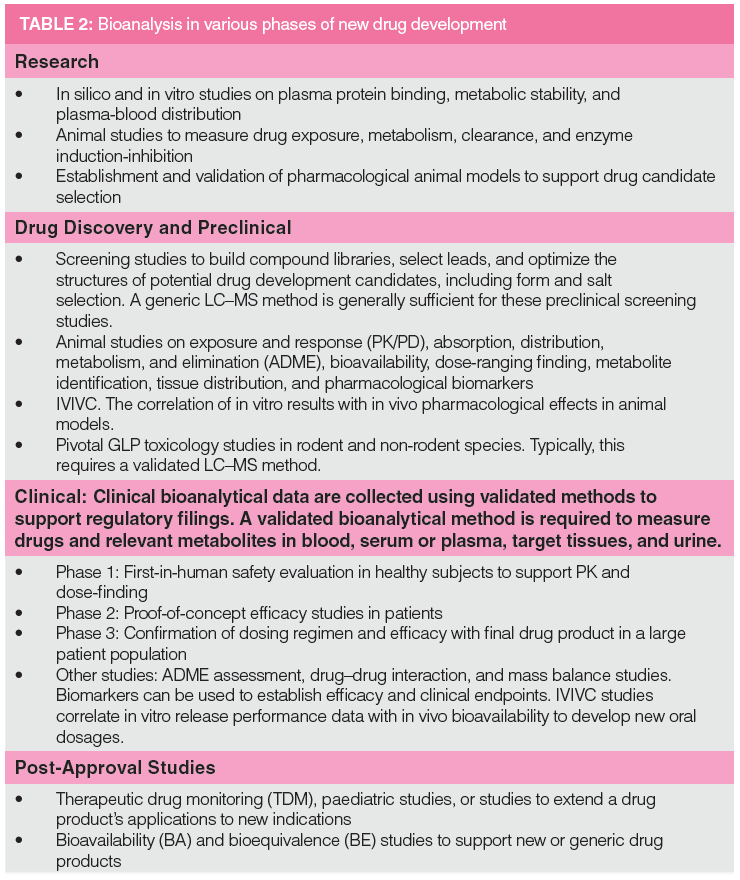
Fundamentals of High Performance Liquid Chromatography (HPLC) and MS in Bioanalysis
LC–MS is the primary analytical technique for the quantitative bioanalysis of small-molecule drugs in physiological fluids. This section describes LC–MS fundamentals and the rationales for selecting reversed‑phase liquid chromatography (LC) with tandem mass spectrometry (MS/MS) detection as the predominant technique. The reader is referred to textbooks and review articles for details on HPLC (including reversed-phase LC [7,8], MS, and LC–MS [9–11]). Table 3 lists the terminologies of HPLC and MS in bioanalysis and the advantages and limitations of reversed‑phase LC with MS/MS detection.
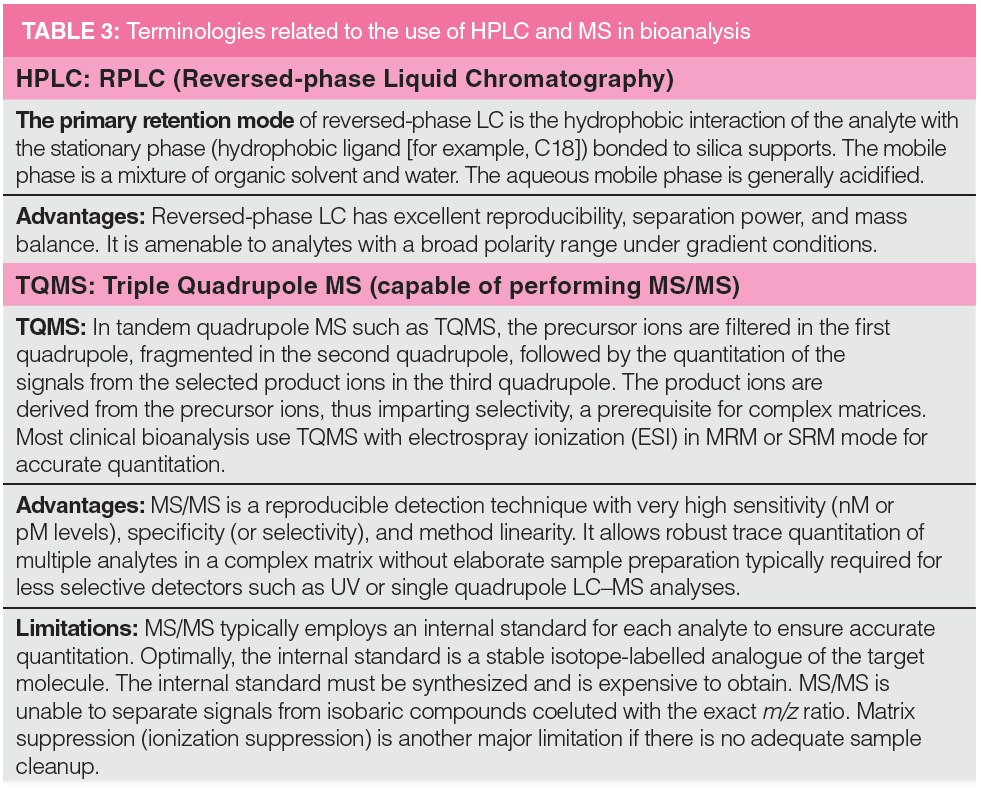
Reversed-phase LC is the predominant LC mode used in bioanalysis. The primary retention mechanism of reversed-phase LC is the hydrophobic interaction of the analytes with a bonded hydrophobic ligand (C18) to silica supports packed inside a column. Because the hydrophobic interaction force is weak, there is a reasonable assurance that all analytes in the sample will be eluted from the column with ~100% mass balance. Reversed-phase LC is amenable to separating analytes with a wide polarity range under gradient conditions (7). Because most small-molecule drugs are basic (<80%), an acidic, aqueous mobile phase is generally used to keep the drug molecule in an ionized state, which also suppresses the silanophilic activity of the bonded phases.
The key limitation of reversed‑phase LC is the lack of retention for hydrophilic analytes that are better separated using a specialized reversed-phase LC bonded phase without end-capping or with a hydrophilic end-capping. A newer LC mode called hydrophilic interaction liquid chromatography (HILIC) has also been used successfully (7). In HILIC, one uses a hydrophilic stationary phase (such as silica) and a mobile phase similar to reversed‑phase LC (acetonitrile and aqueous buffers). The analytes are eluted in an order that is opposite to that of reversed‑phase LC, and the technique is less robust than reversed‑phase LC. HILIC using MS-compatible mobile phases is particularly useful for analyzing secondary metabolites. Other HPLC modes, such as ion‑exchange chromatography (IEC) and size‑exclusion chromatography (SEC), are rarely used in bioanalysis because their mobile phases are generally not MS-compatible.
Triple-quadrupole mass spectrometry (TQMS) or MS/MS with electrospray ionization (ESI) and multiple or selected reaction monitoring (MRM or SRM) is the primary technique used in bioanalysis because of its excellent reproducibility, sensitivity, specifically nanomolar (nM) or picomolar (pM) levels, and specificity (7,11). The impressive linear dynamic range (typically up to three or four orders of magnitude) allows the simultaneous quantitation of the API and lower-level metabolites in the same assay. A drawback of MS detection mode is the requirement of an internal standard for each analyte to compensate for loss during sample preparation, nebulization efficiency in the LC–MS interface, and the ion suppression and enhancement matrix effects (9–11). The internal standard used is preferably a stable isotopically labelled form of the analyte, which must be synthesized or purchased from a commercial vendor and added to the sample early during sample preparation.
Another limitation of MS is its inability to differentiate isobaric compounds. However, many diastereomers from multichiral NCEs can be separated by a well‑developed HPLC method, and most enantiomer pairs can also be resolved using a chiral LC column (7). Ion mobility MS (IMS) is increasingly used to separate isomers based on differences in collisional cross-section. High resolution MS (HRMS) such as time-of-flight (TOF) and orbital trap MS, often available as hybrid (quadrupole time-of-flight, QTOF) instruments or “tribrid” (quadrupole–orbital ion trap) instruments, is a powerful tool for high‑throughput screening applications or structure elucidation of metabolites (11,12). HRMS is invaluable in research to support particular investigations because it has a higher discrimination power to eliminate or reduce interferences from matrix components without MRM. Although they were not typically used in routine quantitative testing in the past, there has been an increasing trend recently in HRMS-based quantitation using new generations of HRMS instruments.
Workflow in Nonregulated and Clinical Bioanalysis
On the laboratory side, the bioanalytical workflow is similar to most analytical testing procedures used in the quality assessment of drug substances and products (7). A key difference is the complex biological sample matrices, which require more sample cleanup, followed by a sensitive and selective quantitation of the API and its specified metabolites. Most bioanalytical studies are project-based, such as PK evaluation for initial NCE screening, good laboratory practice (GLP) toxicology studies, or testing patient samples under good clinical practice (GCP) regulations. The general workflow includes documented procedures such as sampling and sample preparation, method development (calibration, LC–MS parameter optimization), method validation, sample analysis, and data processing and reporting (7,11). The final deliverables can include reports for initial PK studies, phase 1 dose‑ranging for safety evaluation, or phase 4 bioequivalence studies to support new formulations. Reported data yield insights on drug absorption into the systemic circulation for bioavailability, the peak exposure of the drug (Cmax), time taken for the maximum peak exposure (tmax), the half-life (t1/2) for clearance of the drug in plasma, or the investigation of excretion and metabolic profiles, by measuring drug concentrations in plasma, urine, and faeces for mass balance studies.
Regulatory Aspects of Bioanalysis
The development of regulations and guidelines is crucial to ensure ethical, controlled approaches to managing clinical trials and safeguarding the subjects. Efforts to provide regulatory guidance in bioanalysis started in 1990 with a global workshop in Crystal City, Virginia, USA, which marked the beginning of a series of workshops known as “The Crystal City Bioanalytical Workshops” (13). These efforts led to the issuing of much useful regulatory guidance by the US FDA (14). However, it should be noted that this document provides “guidance”, and is not a law or rule. Laboratory personnel should use their best judgment on a case-by-case basis as to the exact methodology for a given method and validation protocol.
Laboratories conducting bioanalytical studies generally operate under GLP guidelines, or Title 21 Code of Federal Regulations (CFR) Part 58 for nonclinical laboratory studies (15). In contrast, most manufacturing facilities operate under good manufacturing practice (GMP) regulations (16). Title 21 CFR Part 58 describes regulatory requirements for GLP facilities, equipment, testing operation, test and control articles, protocols, records, and reports. Other important guidance documents include the Organization for Economic Cooperation and Development (OECD) principles of GLP and consensus document (17), and the regulations on electronic records and signatures as described in 21 CFR Part 11 (18).
International Council for Harmonization (ICH) Guidelines: In an attempt to introduce international regulatory harmonization, a scientific consortium of regulators and pharmaceutical companies from Europe, Japan, and the United States created the ICH for Technical Requirements for Pharmaceuticals for Human Use. The focus of ICH is to improve the efficiency of new drug development, prevent duplication of clinical trials in humans, and minimize animal use while maintaining safeguards on quality, safety, efficacy, and regulatory obligations to protect public health. More information on ICH guidelines is available from www.ich.org. The ICH guideline for the validation of analytical procedure is particularly relevant to bioanalytical method validation (19).
Quality Management System (QMS): At present, the pharmaceutical industry has proactively established a QMS in bioanalysis similar to that described in ICH guideline Q10 (20) for manufacturing, which is focused on strategies and principles to ensure high-quality and consistent data. Some of the key components of the QMS supporting the regulated bioanalysis are listed here:
- Test facility management and resources: This includes the designated staff and facilities for the conduct of the study in a compliant manner.
- Standard operating procedures (SOPs): These are a set of instructions approved by management to ensure the quality and integrity of the data generated in bioanalysis.
- Quality assurance programme: Test facilities have an independent quality assurance (QA) programme to ensure data integrity and compliance with regulations for all programmes.
- Equipment and reagents: Test facilities use validated equipment to generate, store, and retrieve the data. Likewise, the chemicals used in the study are documented with their respective identity, concentration, storage recommendations, stability, and expiration dating.
- Sample handling and storage: Samples are labelled to avoid any ambiguity in identification and stored in recommended conditions to ensure stability. A robust tracking system is in place to provide a chain of custody of all critical samples from receipt to disposal processes.
- Laboratory information management system (LIMS): Most laboratories supporting regulated bioanalysis use validated commercial or in-house developed software to oversee information regarding sample management, study protocols, assay development and validation, and analytical workflow to ensure data accuracy and integrity.
- Clinical study–related aspects: Patient safety, informed consent, and protecting the integrity of the study by installing proper measures to protect critical identification information in studies are the clinical study components that the bioanalytical testing site must also follow.
Modern Trends in Bioanalysis
Finally, we share our views on modern trends in bioanalysis relating to separation science technologies, sample collection and preparation, data analysis, and outsourcing and automation strategies adopted by many progressive pharmaceutical companies and contract research organizations (CROs).
HPLC: HPLC trends in bioanalysis are similar to other HPLC applications with the recent adoption of ultrahigh‑pressure LC (UHPLC) and sub-2-µm columns to increase throughput and separation efficiency. Superficially porous particles (SPPs) are used to enhance column efficiencies (7) and HILIC for separating primary and secondary metabolites if reversed-phase LC does not retain them. Chiral LC is needed to separate enantiomers, although achiral reversed-phase LC methods are adequate for separating diastereomers for multichiral API. Faster autosamplers capable of injecting several samples per minute are used for high‑throughput screening applications. Many LC–MS systems are multiplexed with parallel pumps and multi-samplers to increase sample throughput (7).
MS: MS/MS using TQMS with MRM or SRM detection remains the dominant preclinical and clinical testing technique. A wide linear dynamic range allows for simultaneous quantitation of the API and its metabolites. Modern TQMS instruments are becoming more compact and stackable with reduced footprints and improved ion optics and ion transfer technology for increased sensitivity, dynamic, and mass range. Many modern chromatography data systems (CDS) are updated to perform data handling and MS control for the same manufacturers’ TQMS systems (7).
HRMS using TOF, orbital trap MS, and hybrid MS are commonly used for metabolite identification and structure elucidation (7,12). HRMS is gaining popularity because it can generate more accurate quantitative data in preclinical screening studies to avoid severe interferences from endogenous components in the matrix.
IMS can separate molecules with the exact mass-to-charge (m/z) ratios based on differences in shape or collisional cross-section. IMS is increasingly used to offer an additional dimension for the resolution of isobaric compounds without extensive HPLC method development effort for isomer separations (21).
More Convenient and Efficient Sampling and Sample Preparation:
Dried Blood Spot Testing: The collection and transportation procedures for plasma or serum sample remains a labour-intensive and expensive process. The development of dried blood spot testing received much attention a decade ago for nonregulated and regulated bioanalysis (22,23). However, this testing has several bioanalytical challenges that need to be comprehensively addressed.
Patient-Centric Sampling (PCS): PCS is a hot topic in the bioanalytical field. PCS constitutes new sample collection methods and technologies used in clinical trials where patients can follow instructions to self-collect samples and ship them to the testing facilities (24). Currently, there are multiple commercial vendors offering support in this direction.
Solid-Phase Extraction (SPE)
Microplates and Automation Devices: SPE microplates have improved the automated sample preparation platforms for bioanalysis in complex matrices (25). Innovations in new bonded phase and supports have reduced matrix interferences and allowed more sensitive and accurate assays for many problematic samples. New chemistries in SPE phases will be addressed in the next instalment of this article series. Advances in automation devices that include liquid handling, aliquoting, filtration, and shaking using robotic arms or other platforms have significantly increased productivity in routine testing.
Data Analysis and Artificial Intelligence: Data analysis in bioanalysis is another workflow bottleneck that would benefit from more intelligent data systems and data integration platforms. Artificial intelligence (AI) in big data analysis has been shown to extract valuable clinical data with genetic testing in personalized medicine (26). These concepts and applications may soon expedite the correlation of pharmacological results with bioavailability, PK, drug–drug interaction, and other factors.
Outsourcing Trends: Bioanalytical outsourcing will continue to be a significant part of the regulated bioanalysis strategy of pharmaceutical companies globally. Sponsors are increasingly looking to outsource suitable development workloads to contract research organizations (CROs) for workforce bandwidth to manage additional drug development programmes.
Summary and Conclusions
Bioanalysis of drugs in biological samples is a common LC–MS application performed by thousands of laboratories to support new drug development. It is challenging to generate accurate data of trace analytes in complex matrices in a stringent regulatory environment. In this article, we have strived to provide an overview of bioanalysis to the practising scientist on LC–MS fundamentals, best practices, regulations, and modern trends of this challenging and rapidly evolving analytical methodology.
Acknowledgements
The author thanks the following colleagues for providing timely reviews and comments to improve the final manuscript’s accuracy and clarity: Perry Wang and Jinhui Zhang at the US FDA; Naidong Weng at Janssen, J&J; Jack Henion, professor emeritus of Cornell University; Peng Yu at EpiQMax; and Eric Thomas, Stephanie Cape, and Mark Arnold at Covance.
References
- H. Hill, Bioanalysis 1, 3–7 (2009).
- R.G. Hill and H.P. Rang, Eds., Drug Discovery and Development: Technology in Transition (Churchill Livingston, Edinburgh, Scotland, 2nd ed., 2012).
- K. Whalen, Lippincott Illustrated Reviews: Pharmacology (Wolters Kluwer, New York, New York, USA, 7th ed., 2018).
- H.S. Lee and K-H. Liu, Eds., Drug Metabolism, Pharmacokinetics and Bioanalysis (Mdpi AG, Basel, Switzerland, 2019).
- S.H. Hansen and S. Pedersen-Bjergaard, Eds., Bioanalysis of Pharmaceuticals: Sample Preparation, Separation Techniques and Mass Spectrometry (Wiley, Hoboken, New Jersey, USA, 2015).
- M.L. Rocci Jr. and S. Lowes, Regulated Bioanalysis: Fundamentals and Practice (Springer, Berlin, Germany, 2017).
- M.W. Dong, HPLC and UHPLC for Practicing Scientists (Wiley, Hoboken, New Jersey, USA, 2nd ed., 2019).
- M.W. Dong, LCGC Europe 29(6), 328–337 (2016).
- E. de Hoffmann and V. Stroobant, Mass Spectrometry - Principles and Applications (Wiley Interscience, Hoboken, New Jersey, USA, 3rd ed., 2007).
- J.H. Gross, Mass Spectrometry: A Textbook, 3rd Ed. (Springer, New York, New York, USA, 2017).
- W.A. Korfmacher, Mass Spectrometry for Drug Discovery and Drug Development (John Wiley & Sons, Hoboken, New Jersey, USA, 2012).
- A. Kaufmann, J. Mass Spec. 55, e4533 (2020).
- V.P. Shah and S. Bansal, Bioanalysis 3(8), 823–827 (2011).
- US Food and Drug Administration, Bioanalytical Method Validation, Guidance for Industry (FDA, Silver Spring, Maryland, USA, 2018).
- Code of Federal Regulations (CFR), Title 21, Parts 58 (U.S. Government Printing Office, Washington D.C., USA, 2011).
- Code of Federal Regulations (CFR), Title 21, Part 211.194(a) (U.S. Government Printing Office, Washington, D.C., USA, 2019).
- OECD, Principles of Good Laboratory Practice, Environment Directorate (Organization for Economic Co-operation and Development, Paris, France, 1998).
- Code of Federal Regulations (CFR), Title 21, Parts 11 (U.S. Government Publishing Office, Washington D.C., USA, 2003).
- International Conference for Harmonization, ICH Q2 (R1), Validation of Analytical Procedures: Methodology (ICH, Geneva, Switzerland, November 1996, updated 2005).
- International Conference for Harmonization, ICH Q10, Pharmaceutical Quality System (ICH, Geneva, Switzerland, 2009).
- M.W. Dong, LCGC Europe 33(4), 193–200 (2020).
- D.E. Raynie, LCGC Europe 29(11), 634–637 (2016).
- L. He, R. Gajee, R. Mangaraj, M. P. Waldron, and K.S. Brown, Bioanalysis 12, 393–407 (2020).
- D. Sentellas, J. Saurina, and O. Nunez, in Handbooks in Separation Science (Elsevier, Amsterdam, The Netherlands, 2020), pp. 673–698.
- K.P Bateman, Bioanalysis 12, 971–976 (2020).
- Research and Markets, CISION PR Newswire, Lab Automation in Bioanalysis Markets, 2024 - Rising Demand for Personalized Medicines. https://www.prnewswire.com/news-releases/lab-automation-in-bioanalysis-markets-2024-rising-demand-for-personalized-medicines--technological-innovations-resulting-in-improved-solutions-300872661.html.
ABOUT THE AUTHORS
Shashank Gorityala is a senior staff scientist at Covance, where he supports bioanalytical method development.
David Roos is a senior scientist at Boehringer Ingelheim Pharmaceuticals, where he supports the development of regulated bioanalytical LCÐMS methods for large and small molecules.
ABOUT THE COLUMN EDITOR
Michael W. Dong is a principal of MWD Consulting, which provides training and consulting services in HPLC and UHPLC, method improvement, pharmaceutical analysis, and drug quality. He was formerly a senior scientist at Genentech, a research fellow at Purdue Pharma, and a senior staff scientist at Applied Biosystems/PerkinElmer. He holds a Ph.D. in analytical chemistry from City University of New York. He has authored more than 130 publications and a best-selling book on chromatography. He is an editorial advisory board member for LCGC North America and the Chinese American Chromatography Association. Direct correspondence to: amatheson@mjhlifesciences.com.
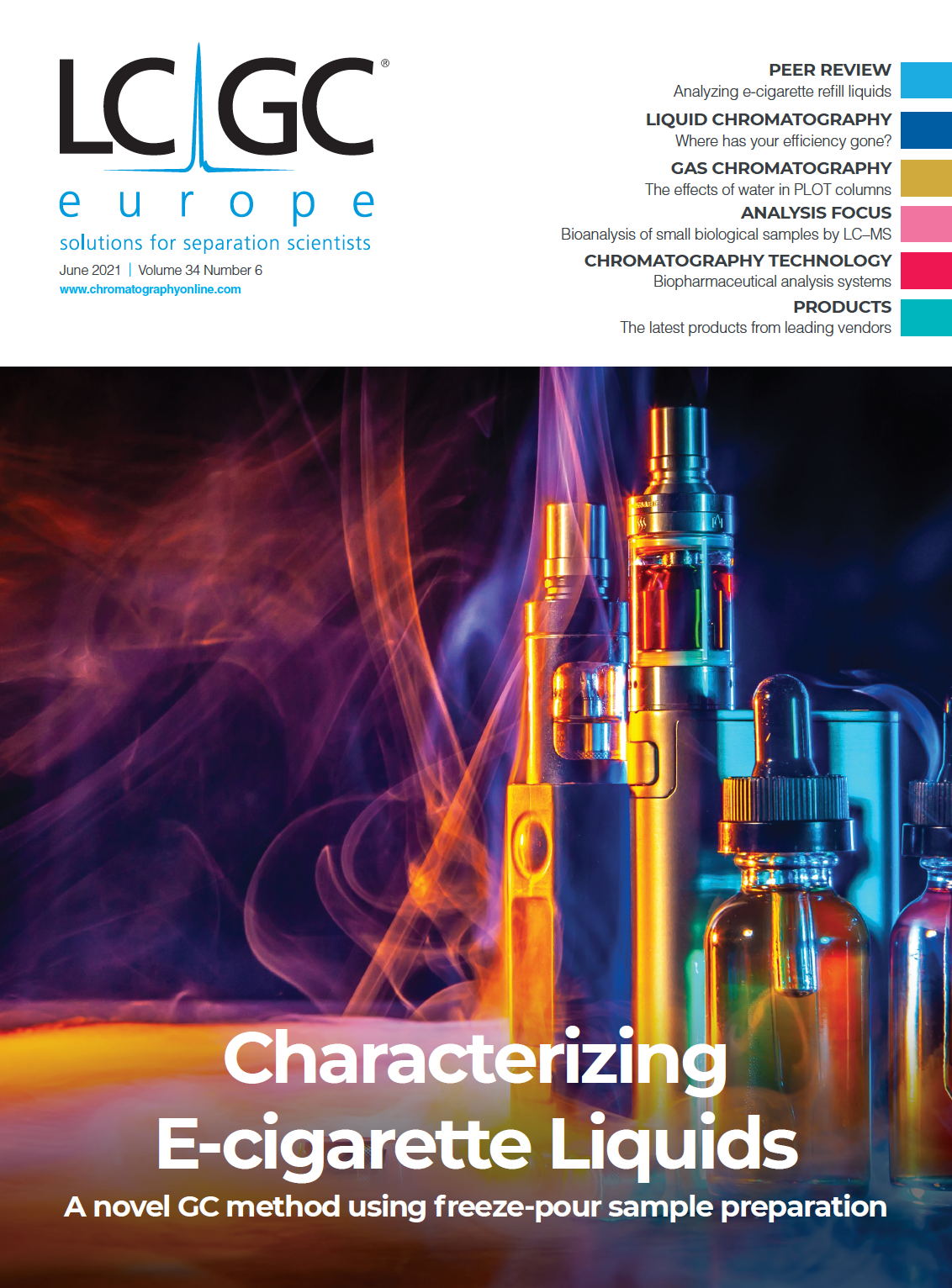
Thermodynamic Insights into Organic Solvent Extraction for Chemical Analysis of Medical Devices
April 16th 2025A new study, published by a researcher from Chemical Characterization Solutions in Minnesota, explored a new approach for sample preparation for the chemical characterization of medical devices.




